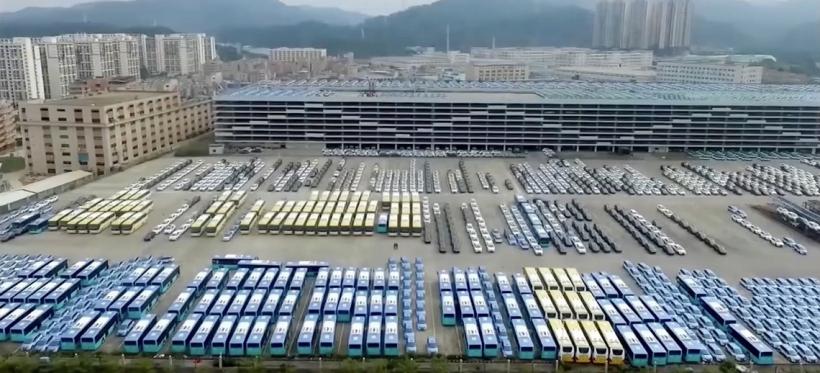
 Shenzhen, China, operates the largest 100% electric bus fleet in the world. Photo by Green Energy Futures/Flickr
Shenzhen, China, operates the largest 100% electric bus fleet in the world. Photo by Green Energy Futures/FlickrLEIPZIG, Germany (May 21, 2019) — The adoption of electric buses, mainly by municipal governments, has accelerated in recent years, increasing more than 80-fold between 2011 and 2017. But cities still have a long way to go. Investment in electric buses and other low-carbon technologies needs to double over the next two decades to keep global warming below safe thresholds, as identified by the IPCC. Reaching this goal will require overcoming specific barriers and encouraging key enabling factors, according to new research from WRI, which examined real-world experiences from 16 cities that have attempted to adopt electric buses to greater and lesser degrees of success.
Two sister reports from WRI, Barriers to Adopting Electric Buses and How to Enable Electric Bus Adoption in Cities Worldwide, break down lessons learned in this rapidly evolving field and provide step-by-step guidance on how to achieve electric bus adoption targets using concrete examples.
“Electric bus adoption to date has been extremely uneven, despite the value to be gained in reducing long-term operating costs, cutting air pollution, and combating climate change,” said Camron Gorguinpour, Global Senior Manager for Electric Vehicles at WRI Ross Center for Sustainable Cities and co-author of the reports. “Every city has run into some problems. This analysis helps others understand these stumbling blocks and how to avoid them.”
Chinese cities account for 99% of electric buses on the road today. China’s pioneering position in the field has yielded valuable insights. In just five years, Shenzhen went from needing two electric buses to secure the service quality of one diesel bus to matching service quality one to one. Today, the city operates the largest 100% electric bus fleet in the world, with more than 16,000 vehicles.
Electric buses typically cost two or three times more than conventional diesel buses. The benefits come from reduced emissions and reduced cost of ownership over the long term. In the case of Izmir, Turkey, the operating costs for 20 electric buses led to an 84% reduction in fuel costs and a 60% reduction in total maintenance costs relative to conventional buses. Izmir’s usage of a solar power plant to provide electricity to charge the buses has resulted in an annual avoidance of around 420 tons of CO2 emissions.
The reports define a total of nine steps to be taken by stakeholders interested in moving toward full electric bus adoption. The first five steps cover initial preparation and planning, and the next four steps address how to scale up to reach mass adoption.
Financing is the main barrier to success. Formalizing and implementing customized procurement plans that are more suited to the special characteristics of electric buses, as well as new financial instruments to diversify and reallocate costs and risks, have offered promising results in places like Santiago, Chile, which leads Latin America in electric bus adoption.
Lesser known issues encountered by early adopters include access to land and adequate electrical supply. Planners in Cape Town, South Africa, for example, found charging infrastructure and new parking schematics required bus depots be up to 40% larger to accommodate charging infrastructure and bigger vehicles. Transit officials in Philadelphia found that existing electric charging capacity covered only about 7% of their bus fleet. Very few cities and national governments have planned for the massive electricity grid upgrades that will be needed. In Zhengzhou, China, electric vehicles, including electric buses, are projected to comprise 36% of the city’s total electricity load by 2020.
The reports emphasize that the top issue for officials to consider first is the scale of their electric bus projects. Cities at the early adoption stages should plan for what’s feasible and take concrete initial actions, like structured yet flexible pilot programs. Cities aiming to scale up should formalize and implement long-term plans regarding infrastructure and procurement, including cost-benefit analyses and actionable, time-bound targets.
“As electric buses grow more popular and cities understand their outsized potential to improve air quality and reduce greenhouse gas emissions, this first-of-its-kind analysis provides invaluable guidance,” said Ani Dasgupta, Global Director of WRI Ross Center for Sustainable Cities. “Detailed case studies and clear next steps demystify the challenges and opportunities of electric buses so more cities can harness their full benefits.”
The reports will launch in Leipzig, Germany, May 22, during a high-level workshop on electric mobility with decision-makers from 19 municipal governments and seven national governments, ranging from places like Kampala that are just starting to consider electric buses to cities like Santiago that have aggressive programs in place.
Contact: Craig Brownstein, +1 202-390-1602, craig.brownstein@wri.org
###
About World Resources Institute
WRI is a global research organization that spans more than 60 countries, with offices in Brazil, China, Europe, Ethiopia, India, Indonesia, Mexico, the United States and more. Our more than 800 experts and staff work closely with leaders to turn big ideas into action at the nexus of environment, economic opportunity and human well-being. More information at www.wri.org.
About WRI Ross Center for Sustainable Cities
WRI Ross Center for Sustainable Cities helps create accessible, equitable, healthy and resilient urban areas for people, businesses and the environment to thrive. Together with partners, it enables more connected, compact and coordinated cities. The Center expands the transport and urban development expertise of the EMBARQ network to catalyze innovative solutions in other sectors, including buildings, land use, energy and water. It combines the research excellence of WRI with 15 years of on-the-ground impact through a network of more than 250 experts working from Brazil, China, Ethiopia, India, Mexico and Turkey to make cities around the world better places to live. More information at www.wrirosscities.org.
 View Map
View Map